Lactate Dehydrogenase (LDH), Isoenzymes of LDH
Lactate Dehydrogenase (LDH)
What sample is needed for the Lactate Dehydrogenase (LDH) enzyme?
- LDH can be done on serum or plasma.
- Can store the sample at room temperature.
- Perform the test immediately.
- The hemolyzed sample is not acceptable because RBC has LDH.
- LDH can be done on urine and CSF.
- LDH can also be done on ascites.
What precautions are needed for Lactate Dehydrogenase (LDH)?
- The serum is preferred to plasma.
- The plasma may not be used due to platelets with high LDH.
- Separate the serum as soon as possible, immediately after the clot formation.
- Do not refrigerate or freeze, and perform the test immediately.
- The hemolyzed serum has 150 times more LDH due to the RBCs, particularly LDH-1 and LDH-2, than the clear serum.
- Oxalate and Borate both inhibit the LDH enzyme activity.
- EDTA also inhibits this enzyme activity.
What are the Indications for Lactate Dehydrogenase (LDH)?
- LDH is used to diagnose diseases or injuries to:
- Heart muscles.
- RBCs.
- Kidney.
- Skeletal muscles.
- Lung.
- Brain.
- Liver.
- It is a late marker of AMI.
- It is a good marker for activity in cryptogenic fibrosing alveolitis and extrinsic allergic alveolitis.
- It is a marker for hemolytic anemia.
- It is a Nonspecific tumor marker.
- Helpful in the diagnosis of exudative fluid in malignant tumors.
- LDH-2 is high in 35% of the cases.
What precautions are taken for Lactate Dehydrogenase (LDH)?
- Hemolysis raises the LDH level, as seen in myocardial infarction.
- There is a raised level of LDH1 and 2 in megaloblastic anemia.
- Avoid poor venipuncture.
- Separate the clot from the serum as soon as possible.
- Avoid heating the sample.
How will you discuss the pathophysiology of Lactate Dehydrogenase (LDH)?
- LDH values refer to the total LDH enzyme in the serum.
- LDH is an enzyme in all body cells and only in the cytoplasm of cells.
- The highest concentration is in the heart, liver, skeletal muscles, kidneys, and RBCs.
- A lesser amount is found in the lungs, smooth muscles, and brain.
- LDH sites of origin released into the blood after the injury are:
- Heart.
- Liver.
- Skeletal muscles.
- RBCs.
- Kidneys.
- Malignant tumors.
- Lungs.
- Lymphocytes.
- Its molecular weight is 134,000 dalton (128,000).
- Its isoenzyme’s molecular structure consists of 4 polypeptide chains with a molecular weight of 32,000 daltons each.
- Two different polypeptide chains, H (heart) and M (muscle) combine into five different arrangements and give rise to five different isoenzymes.
- It consists of four peptide chains of two types, M (or A) and H (or B).
- This M is for muscles, and H is for the heart.
- These are controlled by the loci on human chromosomes 11 and 12, respectively.
- Five isoenzymes make the total LDH. These are separated by electrophoresis (A thin layer of agarose gel).
Distribution of the isoenzymes of LDH:
| Type of isoenzyme | Structure | Distribution % | Distribution in various organs | Diseases Association |
|
HHHH (H4) | 14% to 26% |
|
|
|
HHHM (H3M) | 29% to 39% |
|
|
|
HHMM (H2M2) | 20% to 26% |
|
|
|
HMMM (HM3) | 8% to 16% |
|
|
|
MMMM (M4) | 6% to 16% |
|
|
LDH enzyme level in U/g in various tissues is high as compared to the serum, e.g.:
| LDH in various tissues | Amount of LDH U/g in various tissues |
|
|
|
|
|
|
|
|
|
|
|
|
- The tissue level of LDH is roughly 500 times more than the serum. So contamination with damaged tissue will give very high values.
What is the role of the Lactate hydrogenase enzyme in chemical reaction?
- LDH is an enzyme of the oxidoreductase class that catalyzes the interconversion of Lactic and Pyruvic acid.
- LDH enzyme catalyzes L-Lactate oxidation to Pyruvate, where NAD acts as an H+ acceptor.
- This reaction depends upon the following:
- pH.
- Temperature.
- Substrate.
- Buffers concentration.
- When there is an injury to the cells, LDH spells into the bloodstream.
- LDH is the total measure of isoenzymes of LDH.
- LDH 1 indicates myocardial injury.
- LDH 2 indicates a pulmonary injury.
- LDH 3 indicates a pulmonary injury.
- Total LDH indicates multi-organ injuries like:
- Myocardial infarction.
- Congestive heart failure causes pulmonary and hepatic congestion.
- Advanced malignancies.
- Autoimmune diseases.
Table showing various isoenzymes in various tissues.
| Various organs | LDH isoenzymes | LD-1 | LD-2 | LD-3 | LD-4 | LD-5 |
|---|---|---|---|---|---|---|
| Liver | 4 and 5 | 0.2% | 0.8% | 1% | 4% | 94% |
| Lung | 3 and 2 | 10% | 18% | 28% | 23% | 21% |
| Kidneys | 4 (another ref: 1 and 2) | 28% | 34% | 21% | 11% | 6% |
| Heart | 1 and 2 | 60% | 30% | 5% | 3% | 2% |
| Skeletal Muscle | 4 and 5 | 3% | 4% | 8% | 9% | 76% |
| Cerebrum | 28% | 32% | 19% | 16% | 5% | |
| RBCs | 1 and 2 | 40% | 30% | 15% | 10% | 5% |
| Spleen |
3 | 5% | 15% | 31% | 31% | 18% |
| Skin | 0 | 0 | 4% | 17% | 79% | |
| Lymphocytes |
3 | |||||
| Pancreas | 4 (another ref: 3) | |||||
| Placenta | 4 | |||||
| RES | 2 | |||||
| In normal person |
Major LD-2 followed by LD1>LD3>LD4>LD5 | |||||
What is the normal Lactate Dehydrogenase (LDH) level in blood?
Source 1
- Neonates = 415 to 690 U/L
- Adult = 140 to 280 U/L
Source 2
- Adult = 100 to 190 U/L at 37 °C.
- Newborn = 160 to 450 U/L (30° C)
- Infants = 100 to 250 U/L.
- Child = 60 to 170 U/L
- Isoenzymes: Adult / elderly
- LDH 1 = 17 to 27 %.
- LDH 2 = 27 to 37 %.
- LDH 3 = 18 to 25 %.
- LDH 4 = 3 to 8 %
- LDH 5 = 0 to 5 %.
- The reference ranges are highly method-dependent.
What is Normal LDH in CSF?
- It is ∼10% of the serum level
Where will you see the raised level of Lactate dehydrogenase (LDH)?
Liver disease:
- Ten times raised in toxic hepatitis with jaundice.
- LDH-5 is raised in primary liver disease.
- LDH-5 is raised in the case of liver anoxia.
- LDH-5 is raised in primary liver disease.
- In early hepatitis, there is an increase in LD-5. It may become normal when ALT is still raised.
- There is a moderate increase in cirrhosis, obstructive jaundice, and acute viral hepatitis.
- A marked increase in the LDH-5 occurs in the prodromal stage and is greatest at the onset of jaundice. Total LDH may be increased in 50% of the cases.
- ALT/LD or AST/LD ratio within 24 hours of S/S >1.5 favors acute hepatitis compared to acetaminophen or ischemic injury.
- There is a marked increase in the metastatic infiltrate of the carcinoma.
- LD-4/LD-5 ratio <1.05 favor the diagnosis of liver cell carcinoma.
Lung diseases:
- In pulmonary infarction, there is an increase in LD-2, LD-3, and LD-4.
- In pulmonary embolism, there is an increase in LD-2, LD-3, and LD-4.
- Increased in sarcoidosis.
Hematological disease:
- The case of pernicious anemia and folic acid deficiency shows an increase in LDH, mainly in LD-1, which is >LDH-2, and when the Hb is <8 g/dL.
- LDH is increased in all hemolytic anemias and can be ruled out if LD-1 and LD-2 are not raised in anemic patients.
- LDH is normal in aplastic anemia and iron deficiency anemia, even in the case of severe anemia.
- In sickle cell crises, there is an increase in LD-1 and LD-2.
- Mothers carrying erythroblastic babies show an increase in LD-5.
Medication:
- It is seen in, e.g., Warfarin and antiepileptics.
Alcohol:
- It is increased in repeated drink of alcohol.
Acute Myocardial Infarction:
- LDH rises within 24 to 48 hours.
- The peak is 2 to 3 days (48 to 72 hours).
- Return to normal is a slow process that may take 5 to 10 days.
- It was used for the late diagnosis of AMI.
- That is why the LDH level helps diagnose MI in the late stage, after 4 days of chest pain history.
- LDH >2000 IU suggests a poor prognosis.
- In congestive heart failure, there is an increase in LD-2, LD-3, and LD-4.
LDH may be raised moderately in the following conditions:
- Cardiac failure.
- Acute Myocarditis.
- Rheumatic fever.
- Liver congestion.
Malignant diseases:
- LDH is increased in 50% of the solid carcinomas and the advanced stage.
- LDH levels are raised in lymphomas and liver cell necrosis.
- 70% of the cases with metastasis to the liver have increased LDH.
- It is raised in 20% to 60% of cases without metastasis to the liver.
- High levels are seen in the case of Hodgkin’s disease, abdominal cancer, and lung.
- Leukemias has a moderate increase.
- Raised levels of LDH in cancers show poor prognosis.
- Carcinoma prostate shows increased LD-5, and the ratio of LD-5:1 is >1.0.
- Malignant lymphoma shows increased LD-3 and LD-4. There may be an increase in LD-2 as well.
Kidney diseases:
- It is raised in 1/3 of cases of kidney diseases.
- Mostly in tubular necrosis.
- And in pyelonephritis.
- In the case of renal infarction, the picture is like myocardial infarction.
- LD-1/LD-2 ratio >1 may occur in acute renal infarction, hemolysis, pregnancy, muscle disorders, and cancers.
Muscular dystrophy:
- There is a moderate increase in progressive muscular dystrophy, particularly in the disease’s early and mid stages.
- LDH-5 is mainly increased in the anoxic injury of the striated muscle.
- After damage or loss of the large muscle mass, the LDH level declines.
- There is an increase in total LDH in electrical and thermal burns and trauma of the muscles.
Cerebrospinal fluid:
- Normally, it is lower than the serum.
- LDH-4 and LDH-5 are not found in the CSF.
- In bacterial meningitis, WBCs raise the level of LDH-4 and LDH-5.
- In the case of viral meningitis, the lymphocytes increase the level of LDH-1 and LDH-3.
Cerebrovascular accidents:
- LDH increases in most cases, and peak levels are 1 to 3 days.
- It does not relate to xanthochromia, RBCs, WBCs, protein, sugar, or chloride.
- The subarachnoid and subdural hemorrhage increases all subclasses of LDH, especially LD 3, 4, and 5.
CNS neoplasia:
- There is an increased LD5 >9% and a decreased LD-1: LD-5 ratio <2.5 in the absence of infection or hemorrhage, suggesting neoplasia in the meninges.
- LD-5 >10% suggests high-grade neoplasm.
- LD-3 and LD-4 increase; occasionally, LD-5 is seen in the leukemic and lymphomatous infiltration.
Meningitis:
- There is a mild increase in viral meningitis.
- There is an increase in LD-1 and LD-2 in viral meningitis.
- There is a marked increase in bacterial meningitis.
- There is an increase in the LD-4 and LD-5 in bacterial meningitis.
- TB meningitis shows an increase in LD-1, LD-2, and LD-3, especially LD-3.
- HIV infection does not make much difference.
Urine:
- Total LDH raised level in the urine indicates urologic injury.
- Three to five times raised level is seen in:
- Chronic glomerulonephritis.
- Systemic lupus erythematosus.
- Diabetic nephropathy.
- Urinary bladder and kidney tumors.
- LDH levels may be done in the pleural, cardiac, or peritoneal fluids to differentiate exudate or transudate.
LDH isoenzymes increased in various diseases :
- LDH-1 increased in renal infarction.
- It is raised in the testes’ germ cell tumor-like seminoma and teratoma.
- And dysgerminoma of the ovary.
- It is raised in the testes’ germ cell tumor-like seminoma and teratoma.
- LDH-3 increased in pulmonary infarction.
- LDH-3 and LD-4 increased in lymphoproliferative disorders.
- LDH-4 may be the main isoenzyme in acute lymphoblastic leukemia.
- Normal LDH-1: LDH-2 ratio = <0.80, while myocardial infarction is >0.80.
- LDH-1 > LDH-2 in hemolytic anemias and pernicious anemia.
What are other conditions where LDH is raised?
- Parasitic infestation.
- Various infections.
- Viral infections show an increase in LD-2, LD-3, and LD-4.
- Subacute thyroiditis and hypothyroidism.
- Acute pancreatitis.
- Collagen vascular diseases.
- SLE (LD-3 and LD-4).
- Drugs.
- Intestinal obstruction.
- Sarcoidosis.
- Bacterial meningitis, cerebral hemorrhage, or thrombosis.
- Dermatomyositis (LD-5).
What are the conditions where there is a decreased level of LDH?
- It may be seen in irradiation.
- LDH is distributed in multiple organs, so the total LDH is not a specific marker for any disease or injury.
Serum LDH Isoenzymes in various diseases:
| Diseases | LDH Isoenzymes raised |
| Acute Myocardial infarction | I and II (LD-1>LD-2) |
| Congestive heart failure | LD2, LD3, LD4 |
| Acute renal cortical infarction | LD 1 > LD2 |
| Pulmonary embolus without hemorrhage | III (LD-3) |
| Pulmonary embolism with hemorrhage | I, II, III (LD-1, LD-2, LD-3) |
| Sickle cell crises | I, II (LD-1 and LD-2) |
| Pernicious anemia | I (LD-1) |
| Acute MI with congestion of the liver | I, V (LD-1 and LD-5) |
| Early hepatitis | V (LD-5) |
| Malignant Lymphomas | III, IV (LD-3 and LD-4 |
| Dermatomyositis | V (LD-5) |
| Lupus erythematosus | III, IV (LD-3, and LD-4) |
| Prostatic carcinoma | V (LD-5), 5:1 ratio >1 |
| Viral infection | LD2, LD3, LD4 |
| Strenuous exercise | LD4 and LD5 |
Question 1: What is the significance of LDH in active chronic granulocytic leukemia.
Question 2: Which isoenzyme is increased in pernicious anemia.

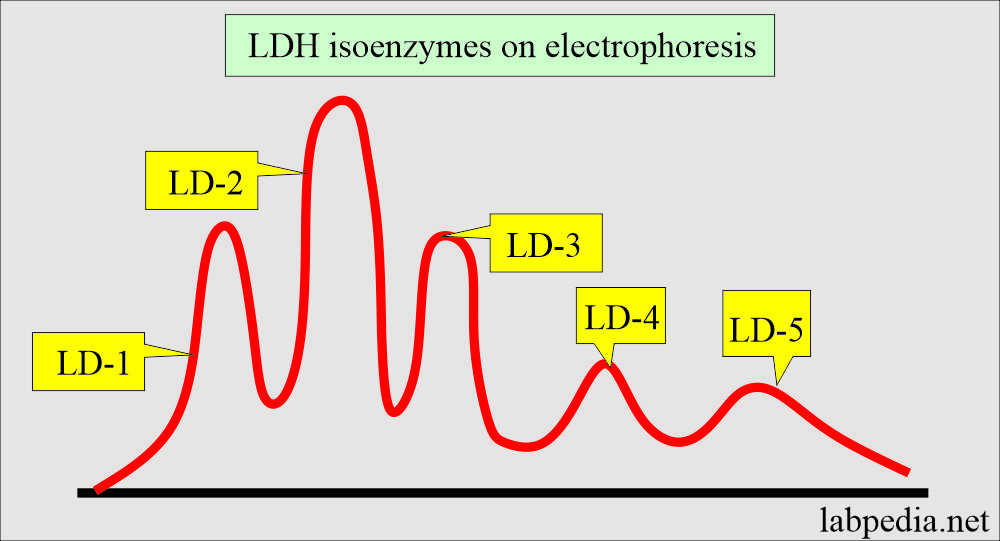
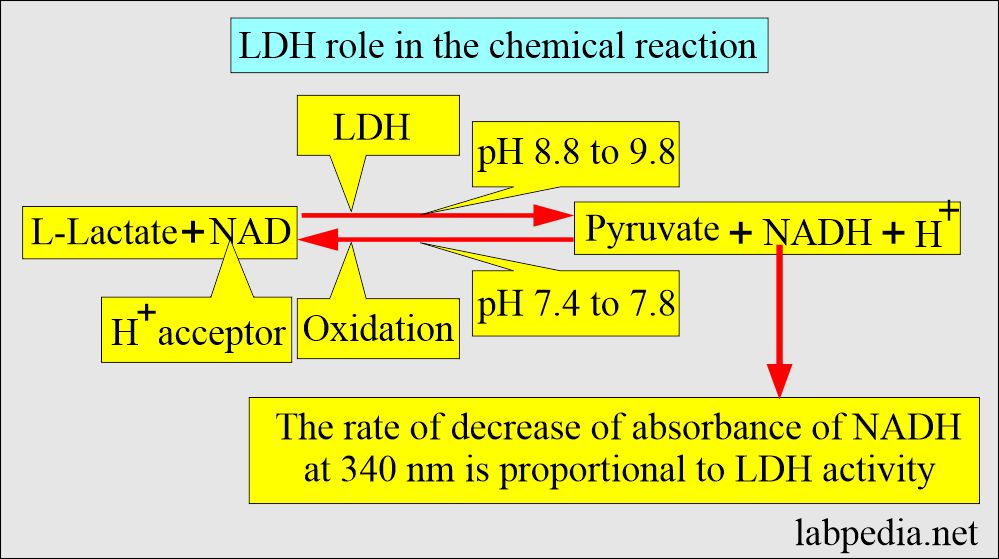
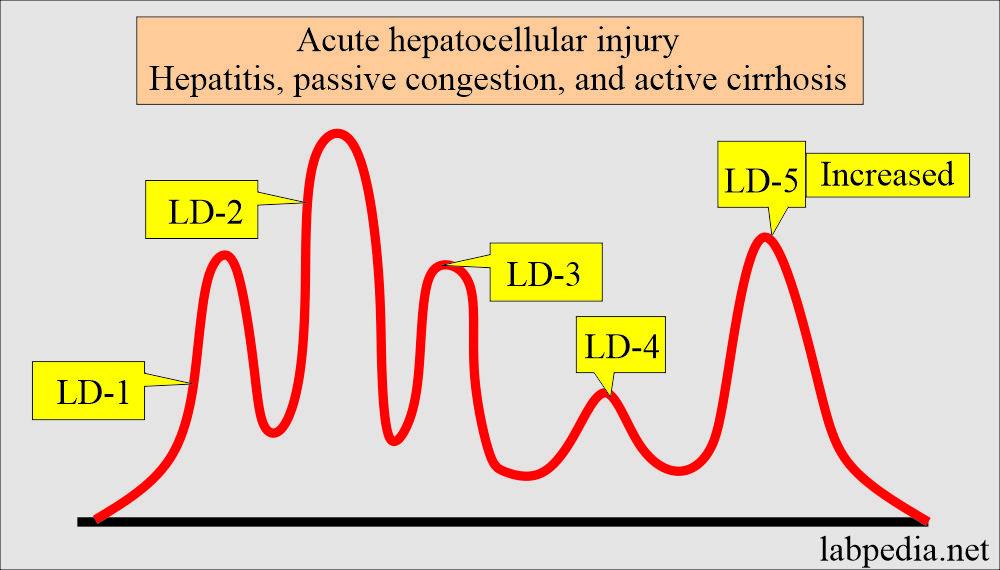
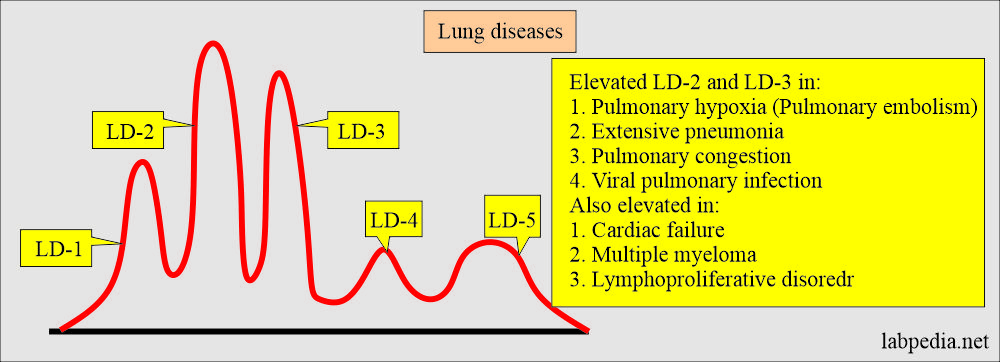
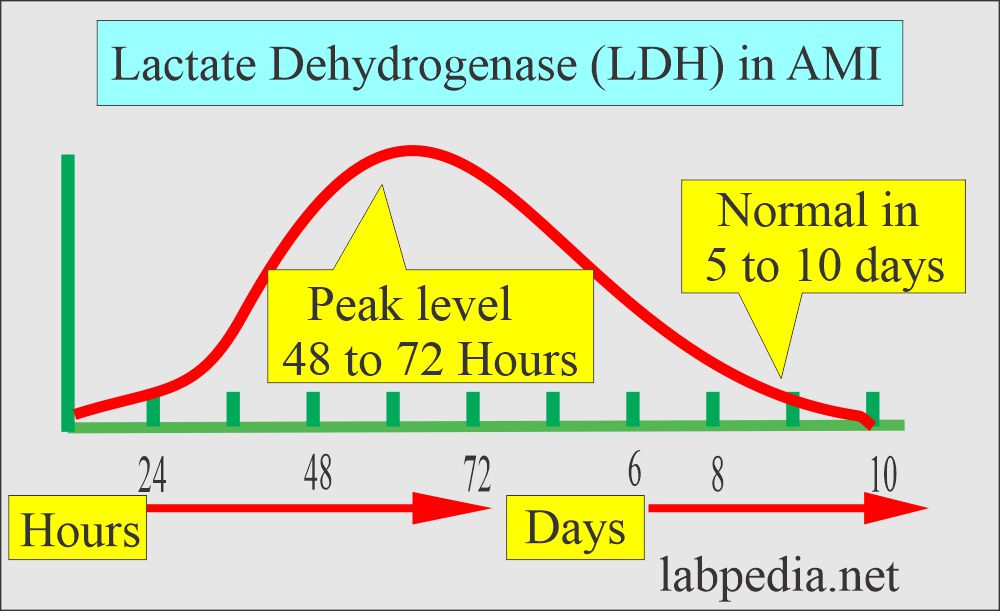
Laboratory technician